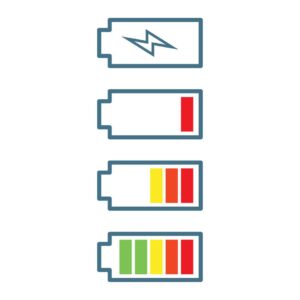 Often an afterthought, batteries are an important power source for IoT sensors. Without a battery, some sensors would not be able to gather and transmit data. When sensors are placed in remote locations in a factory or facility, easy access to an electrical outlet is not always feasible. In these situations, most sensors use a battery to allow independent operation.
Often an afterthought, batteries are an important power source for IoT sensors. Without a battery, some sensors would not be able to gather and transmit data. When sensors are placed in remote locations in a factory or facility, easy access to an electrical outlet is not always feasible. In these situations, most sensors use a battery to allow independent operation.
However, when most companies are planning an IoT implementation, the impact of battery life and sensor locations on the overall cost of the implementation is underestimated. Hard to reach sensors require additional, expensive labor to replace batteries, so reducing or eliminating the need to replace batteries results in an overall more cost-effective solution.
Energy Harvesting for Sensors
Energy harvesting is a technique used to power IoT sensors by collecting energy from the environment, such as sunlight, heat, vibration, or radio waves. It can help to extend the lifetime of the battery in the sensor and reduce the need for maintenance. Examples of energy harvesting for sensors includes:
- Solar energy harvesting using photovoltaic cells to convert sunlight into electricity
- Thermal energy harvesting using thermoelectric generators to convert temperature differences into electricity
- Vibration energy harvesting using piezoelectric materials to convert mechanical motion into electricity
- RF energy harvesting using antenna to convert radio frequency signals into electricity
It is important to note that, depending on the type of sensor and its location, energy harvesting may not be a feasible option for all IoT sensors.
Impact on Sensor Size
Energy harvesting can have an impact on the size of an IoT sensor, depending on the type of energy harvesting method used.
- Solar energy harvesting, for example, requires the addition of a solar panel to the sensor, which would increase its size.
- Similarly, thermal energy harvesting would require a thermoelectric generator, which would also add to the size of the sensor.
- Vibration energy harvesting, on the other hand, can be incorporated into the sensor design in a compact form. For example, using a piezoelectric material as the body of the sensor or as a structural component can help to minimize the impact on size.
- RF energy harvesting does not add much size to the sensor, as the antenna can be integrated into the sensor design.
Overall, it is important to consider the trade-offs between size, cost, and energy efficiency when implementing energy harvesting in an IoT sensor.
At Embedded Planet, we have worked to solve the ever present question of how to power remote sensors without the need to replace batteries and, in some cases, without the need for batteries at all. With energy harvesting, we can apply the appropriate technology – solar, thermoelectric, RF, or vibration – to ensure that there is never a need for the user to replace or recharge the battery.
For some applications, the battery-less approach can be taken. EP has demonstrated sensor applications that do not require a battery and are powered solely by energy harvested from the environment.
Contact our engineers to find out how to get more about our innovative energy harvesting sensor capabilities.

 Often an afterthought, batteries are an important power source for IoT sensors. Without a battery, some sensors would not be able to gather and transmit data. When sensors are placed in remote locations in a factory or facility, easy access to an electrical outlet is not always feasible. In these situations, most sensors use a battery to allow independent operation.
Often an afterthought, batteries are an important power source for IoT sensors. Without a battery, some sensors would not be able to gather and transmit data. When sensors are placed in remote locations in a factory or facility, easy access to an electrical outlet is not always feasible. In these situations, most sensors use a battery to allow independent operation.












